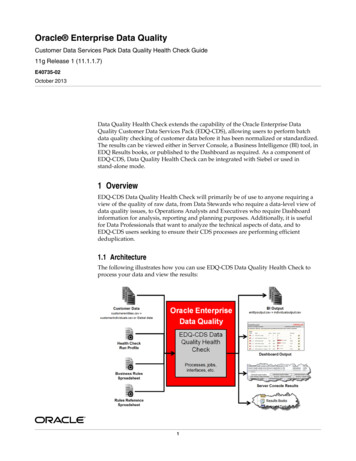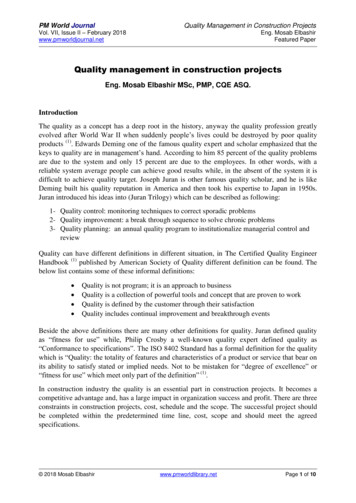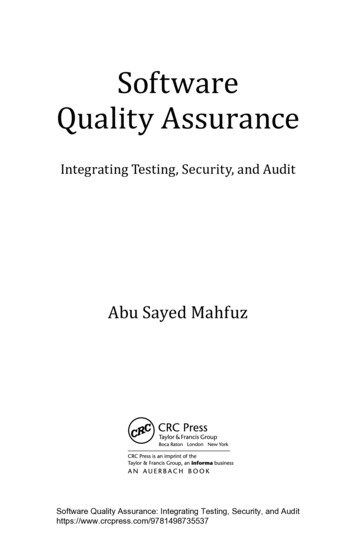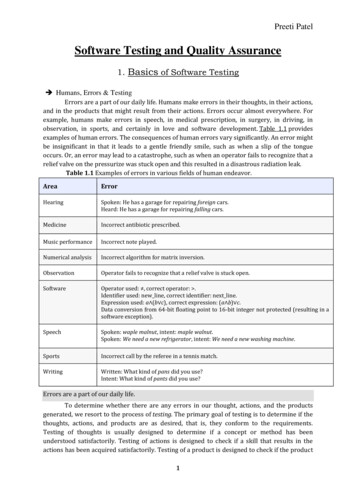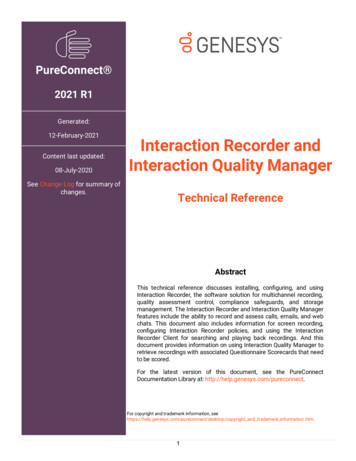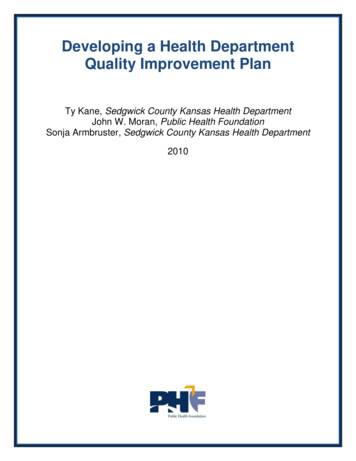
Transcription
Developing a Health DepartmentQuality Improvement PlanTy Kane, Sedgwick County Kansas Health DepartmentJohn W. Moran, Public Health FoundationSonja Armbruster, Sedgwick County Kansas Health Department2010
Developing a Health Department Quality PlanTy Kane, John Moran, and Sonja Armbruster1Introduction:Why should a public health department build a Quality Improvement (QI) Plan? What should itinclude? Who should be involved in developing the plan? How will this help us in ouraccreditation activities? These are the questions that usually arise when a public health agencythinks about developing a QI Plan. When the initial QI Plan is developed, it is a basic documentof what you are planning to accomplish. After that, it should be updated regularly to indicatewhat you are doing. A QI Plan is not a one- time event, but rather a continuing process ofimprovement that shows what is actually happening to ensure customer satisfaction. A QI Planis a document that provides written credibility to the entire QI process. The QI Plan is a visiblesign of management support and commitment to quality throughout the organization.The QI Plan is a basic guidance document about how a public health department will manage,deploy, and review quality throughout the organization. The main focus is on how we deliverour products and services to our customers and how we ensure that they are aligned withcustomers’ needs. The QI Plan describes the processes and activities that will be put into placeto ensure that quality deliverables are produced consistently. Over time, the QI planning,business planning, and strategic planning will be integrated into one aligned document. Initially,however, the QI Plan needs to be separate to give it the proper focus and attention throughoutthe organization.Elements of a Quality Plan:The QI Plan contains the following basic information: Describe the overall management approach to quality and what is to be accomplished(goals) over a defined time frame. This is the purpose and policy statement of theorganization as to why it is focusing on quality. There should be a clear organizationalmission that employees can relate to in their daily work. It should describe key qualityobjectives and how we plan to elicit the customer’s expectations in terms of quality and toprepare a proactive quality management plan to meet those expectations. Describe key terms so that everyone has the same vocabulary when it comes to theterms used to describe quality and QI. It is important to have consistent languagethroughout the organization to avoid misconceptions and unclear messages. Describe how the quality program will be managed and monitored by the organization.Some organizations have a formal Quality Council to manage and prioritize the qualityactivities while others use an existing management committee structure to accomplishcoordination of QI activities.1Ty Kane, Community Health Analyst, Sedgwick County Health Department, John Moran, Senior QualityAdvisor, Public Health Foundation, Sonja Armbruster, Community Health Assessment Coordinator,Sedgwick County Health Department1
Describe the process for selecting QI projects and team leaders.Describe the types of training and support that will be available to the organization as awhole, facilitators, team leaders, and team members.Describe the quality process (i.e.: Plan-Do-Check-Act (PDCA)) and quality tools andtechniques to be utilized throughout the organization. It is best to adopt oneimprovement model for the organization to avoid confusion and competition.Describe how updates to planned QI activities and processes will be communicated tomanagement and staff on a regular basis to keep them informed as to what progress isbeing achieved. The communication plan is an essential ingredient of any QI Plan since itshows results which should inspire others to try it.Describe any quality roles and responsibilities that will exist in the organization (i.e.,sponsor, team leader, team member, facilitator, etc.) during or after implementation.Describe how measurement and analysis will be utilized in the organization and howthey will help define future QI activities.Describe any evaluation (Quality Assurance) activities that will be utilized to determinethe effectiveness of the QI Plan’s implementation.As each of these sections is developed and approved, establish a review time for updates onwhat is actually happening. The review team should analyze any section that is behind schedule,or whose goals have not been achieved, and identify lessons learned to make the next iterationof the QI Plan an improved document with an achievable plan.Summary:The QI Plan is a guidance document that informs everyone in the organization as to thedirection, timeline, activities, and importance of quality and QI in the organization. The QI Plan isa living document and needs to be revised on a regular basis to reflect accomplishments, lessonslearned, and changing organizational priorities. It is not a one-time static document but one thatshould constantly describe the current state and future state of quality in any public healthdepartment.2
Sample Quality Improvement PlanSummarized below is an example of a QI Plan for the XYZ Health Department.1. Purpose:To establish a policy and procedure for quality improvement (QI) activities within the XYZHealth Department.Policy Statement:The XYZ Health Department has an interest in systematically evaluating and improving thequality of programs, processes and services to achieve a high level of efficiency,effectiveness and customer satisfaction. To achieve this culture of continuous improvement,QI efforts should target the department-level (“Big QI”) as well as the program- or projectlevel (“little qi”).2. Definitions (some examples):2Strategic planning, program planning, and evaluation: Generally, strategic planning and QIoccur at the level of the overall organization, while program planning and evaluation areprogram-specific activities that feed into the Strategic plan and into QI. Program evaluationalone does not equate with QI unless program evaluation data are used to design programimprovements and to measure the results of implemented improvements.Continuous quality improvement (CQI): An ongoing effort to increase an agency’s approachto manage performance, motivate improvement, and capture lessons learned in areas thatmay or may not be measured as part of accreditation. Also, CQI is an ongoing effort toimprove the efficiency, effectiveness, quality, or performance of services, processes,capacities, and outcomes. These efforts can seek “incremental” improvement over time or“breakthrough” all at once. Among the most widely used tools for continuous improvementis a four-step quality model, the PDCA cycle.Quality improvement (QI): An integrative process that links knowledge, structures,processes and outcomes to enhance quality throughout an organization. The intent is toimprove the level of performance of key processes and outcomes within an organization.2The following definitions are from the Public Health Accreditation Board, Acronyms and Glossary ofTerms, July 15, 2009, 07-15-2009.doc, accessed11/12/2010.3
Quality Improvement Plan: A plan that identifies specific areas of current operationalperformance for improvement within the agency. These plans can and should crossreference one another, so a QI initiative that is in the QI Plan may also be in the strategicplan.Quality methods: Practices that build on an assessment component in which a group ofindicators that are selected by an agency are regularly tracked and reported. The datashould be regularly analyzed through the use of control charts and comparison charts. Theindicators show whether or not agency goals and objectives are being achieved and can beused to identify opportunities for improvement. Once selected for improvement, the agencydevelops and implements interventions, later reassessing to determine if interventions wereeffective. These quality methods are frequently summarized at a high level as the PDCA orShewhart Cycle.33. Overview of Quality in the Agency:Describe the current state and desired future state of quality in the organization. Be honestand open about the current state since it is the base upon which you are building. The moreaccurate you are in describing the current state the better able you will be at determiningthe gap that exists reaching the desired future state. Closing the gap may take a few years,but it is where we want to be. The accurate gap analysis will also allow you to understandand determine the resources that it will take to reach the desired future state.The current state of QI in the XYZ Health department is at the beginning stage with somestaff trained in QI tools and techniques; the department follows the PDCA cycle, and wehave completed six “little qi” projects. For the next year we want to give every member ofthe health department an introduction to the QI course, train 20% of our staff in the detailsof QI, complete six more “little qi” projects, and start one “Big QI” project.4. Governance Structure: (formal or informal):The key elements of the governance structure that need to be addressed are as follows: Organization structure – quality council, senior management leadership team, etc. Membership and rotation Roles and responsibilities Staffing/administrative support3M. Best and D. Neuhauser (2006). Walter A Shewhart, 1924, and the Hawthorne Factory. Quality andSafety in HealthCare, 15(2): 142-143. 6/ accessed11/12/2010.4
Examples of what could be in these sections are shown below.The “Q-Team” will carry out QI efforts at the XYZ Health Department. Examples of theseefforts will include: Developing a comprehensive QI Plan; preparing to meet local healthdepartment accreditation standards related to QI; and developing and evaluating rapid cycleQI tests. Q-Team members will also plan and participate in a number of QI training activities.QI training will likely include some independent study along with multiple trainings at theXYZ Health Department or other sites.The Q-Team will consist of approximately 11 members, representing a cross-section of eachlevel of the organizational chart, including: administration, division managers, programmanagers and program staff. Additional ad-hoc members (representing HIPAA compliance,human resources, strategic planning and finance) will be engaged in Q-Team activities on anas-needed basis.Q-Team members will serve a two-year term, with no more than half of the team rotatingoff each year. Co-chairs will be selected for a two-year term with a staggering rotation. Oneco-chair must be a Division Director or Administrator. Q-Team members will be expected toattend regular monthly meetings (approximately 1.5 hours per month), QI trainings(approximately 2 hours per month), and engage in mentoring activities with other staff(approximately 2 hours per month).45. Training (what are the trainings desired and the target population): Presentation at new employee orientation meetingIntroductory online course for all staffDevelop 5 QI Coordinators who will have detailed QI knowledge and be a resource to QIteamsContinue ongoing staff trainingOther training as needed - position-specific QI training (MCH, Epidemiology, etc.)If available, staff could partner with a local health system or other private corporation todevelop their understanding of QI6. Describe how Quality Improvement projects are identified, prioritized, staffed, andinitiated within the agency.In this section the XYZ Health Department would describe how it will prioritize the areason which to focus QI projects, what data will be used to do the prioritization, and how itwill ensure that the projects are aligned with its strategic vision. Projects may be4This language was adapted from the “Spokane Regional Health District 2009 QI Plan.”5
identified from a MAPP5 process, self-assessment, customer satisfaction surveys, orformal organizational review that identifies gaps in services. Whatever method is used,the process needs to be documented and show alignment with the desired future state.7. Quality Goals:The health department must develop specific quality goals for their organization, themeasures that will be used to track progress to the goal, and the timeline for completion.Goals should be developed for the short- and long-term so that employees see what isgoing to happen immediately as well as what the future may bring.One year goals, objectives, and timelines (planned or in-process activities): All staff willreceive a one-hour introduction to QI in the first quarter of 20XX.Three-year goals, objectives, and timelines (planned activities): In three years ourorganization will have moved from “little qi” to “Big QI” agency-wide and will havedeveloped a culture of customer satisfaction that will show a 30% increase in customersatisfaction scores.8. Describe how the quality program is measured, monitored and reported:Describe any annual/quarterly/monthly evaluation of the quality program and howgoals and objectives are revised. Some measures that organizations can use arecapacity, process, and outcome measures. Capacity Measure – 50% of all leadership staff will be trained and able to lead a QIteam by the second quarter of 20XX. Process Measure – All QI teams chartered by the organization will follow the PDCACycle, develop AIM statements, and focus on discrete projects that can becompleted in three months of the team’s start date. Outcome Measures – 90% of teams charted will complete their projects on time andwill have a direct impact on our strategic objectives.9. Describe how quality is communicated throughout the organization on a regular basis.It is important to have regular communication on quality improvement to all staff oncethe initiative is launched so that they can be knowledgeable of what is happening in theagency. Regular updates on how the quality improvement plan is being implemented,5Mobilizing for Action through Planning and Partnerships (MAPP).6
training activities being conducted, and improvement teams charted are key parts of anycommunication plan. Some organizations have a monthly “Q” letter that is e-mailed toall staff; others have regular all-hands meetings in which updates are given, and stillothers use staff meetings to convey the message.10. Add other agency-specific topics as required:For further information or comments, please contact the Public Health Foundation atinfo@phf.org.7
Quality Improvement Plan: A plan that identifies specific areas of current operational performance for improvement within the agency. These plans can and should cross-reference one another, so a QI initiative that is in the QI Plan may also be in the strategic plan. Quality methods: Practices that build on an assessment component in which a .


